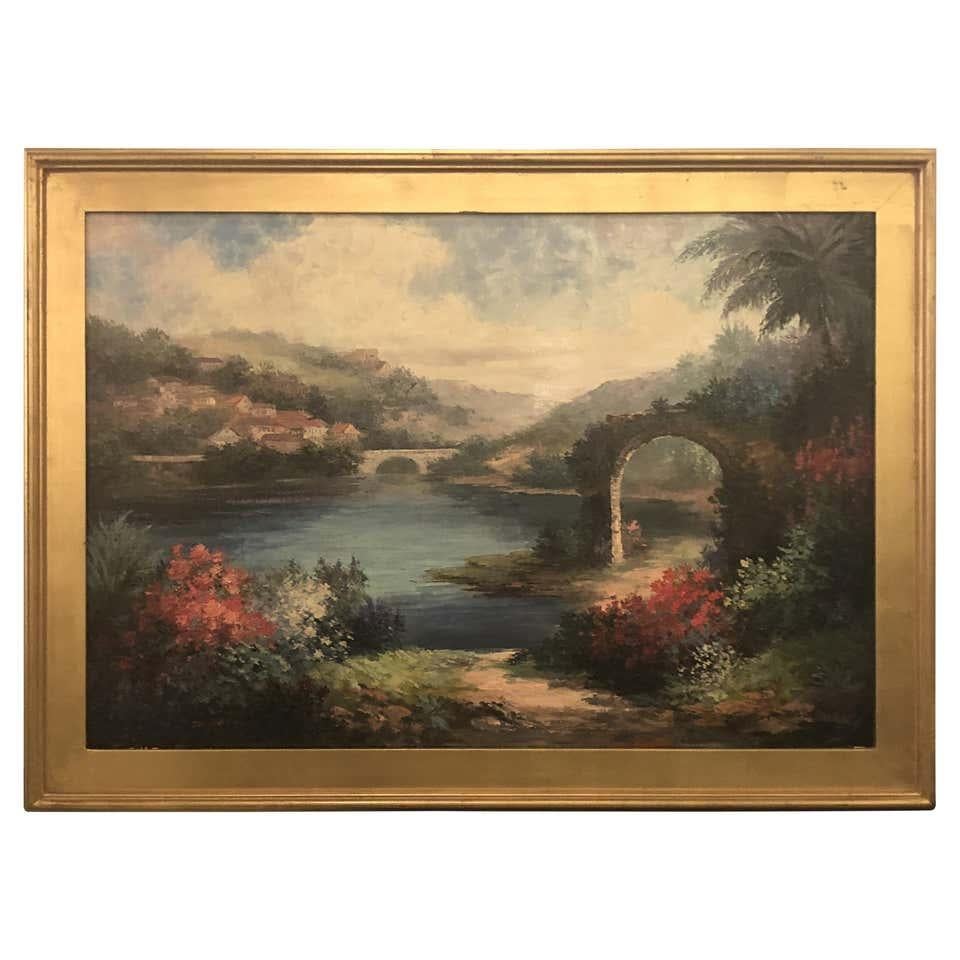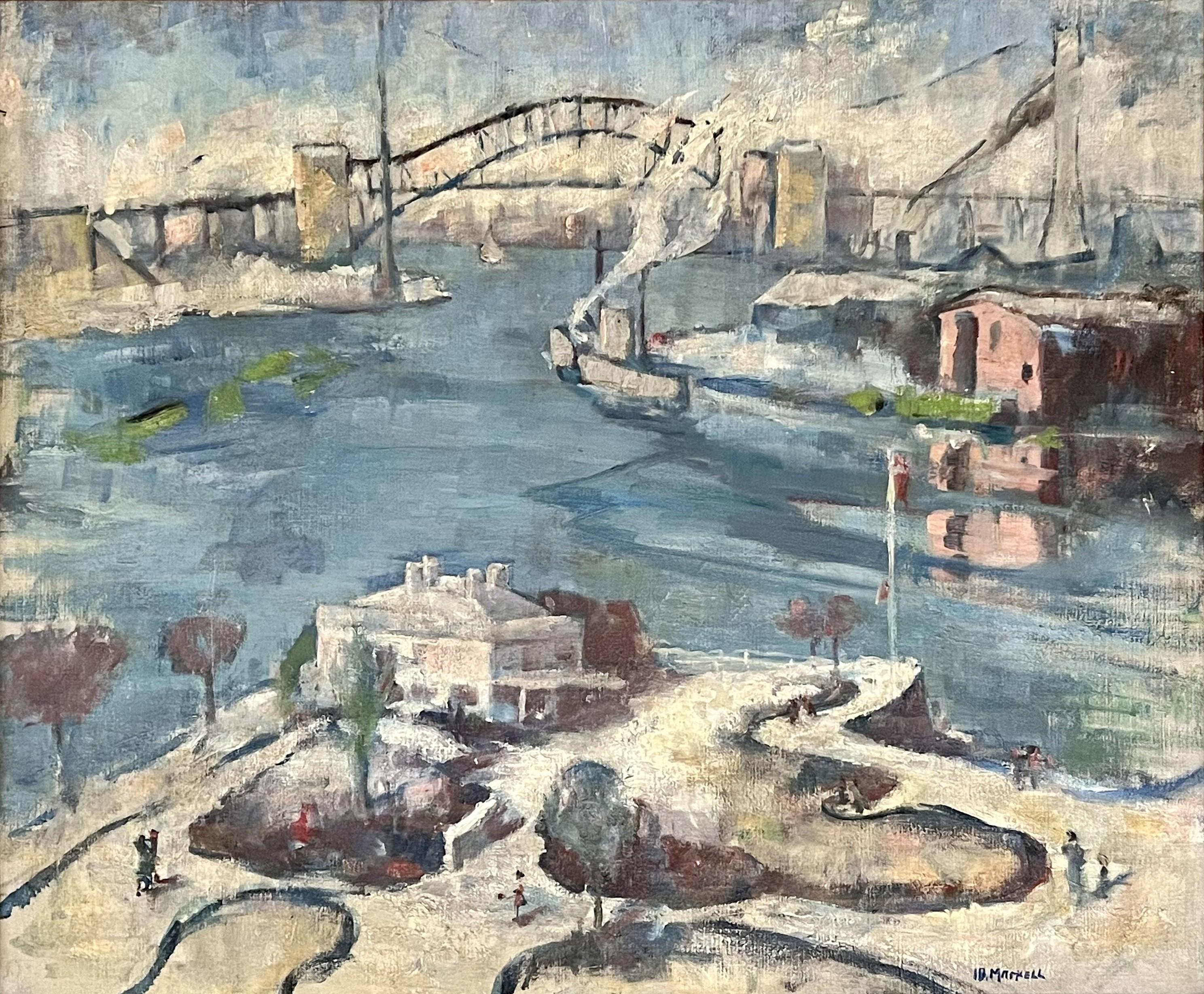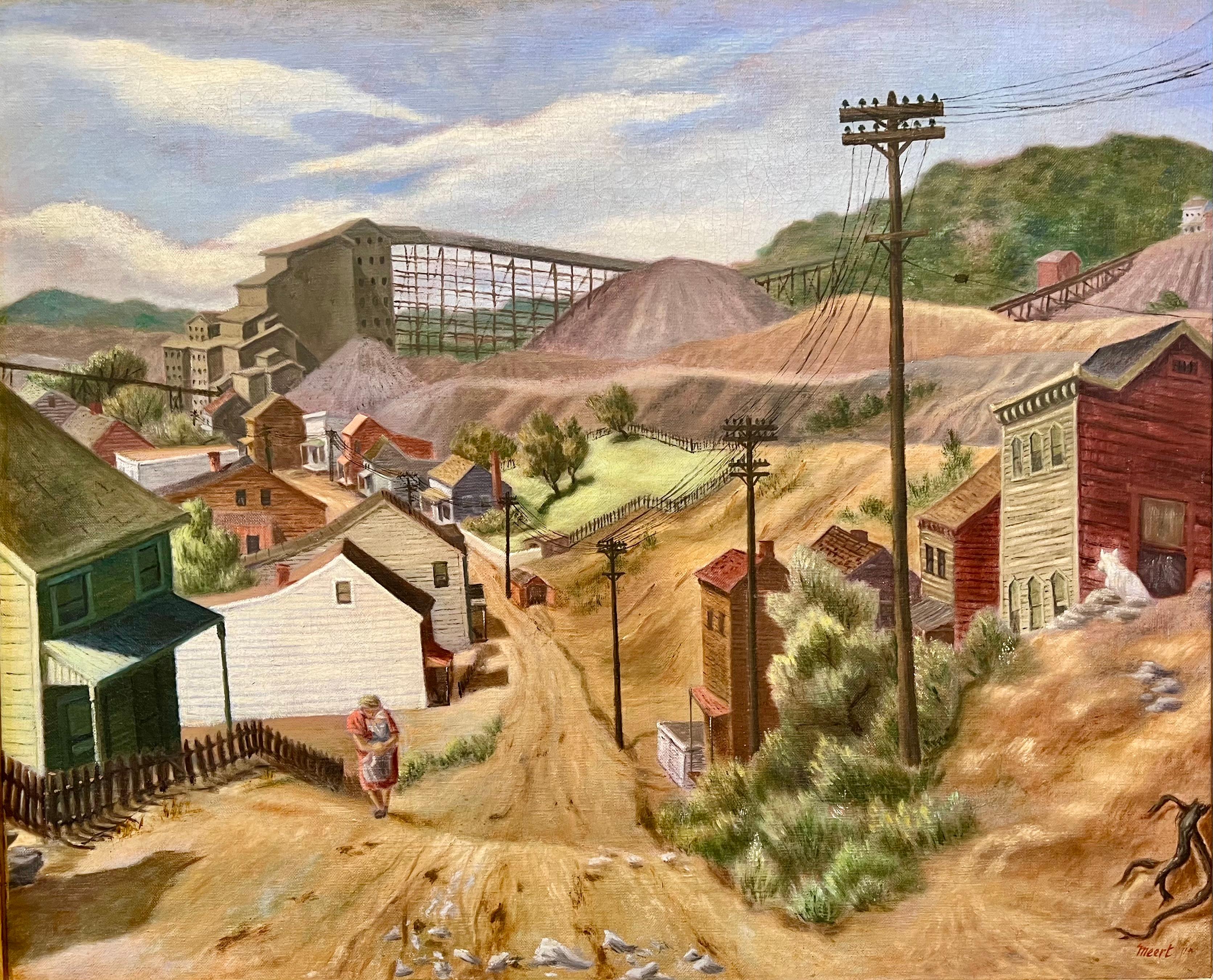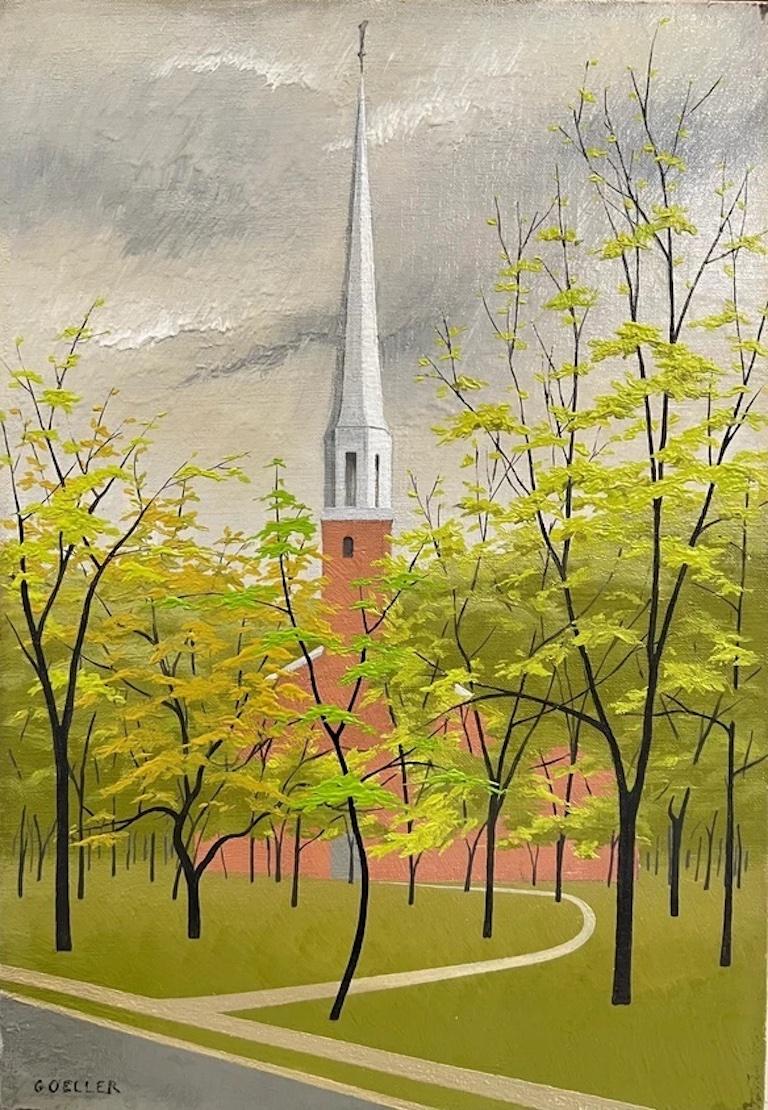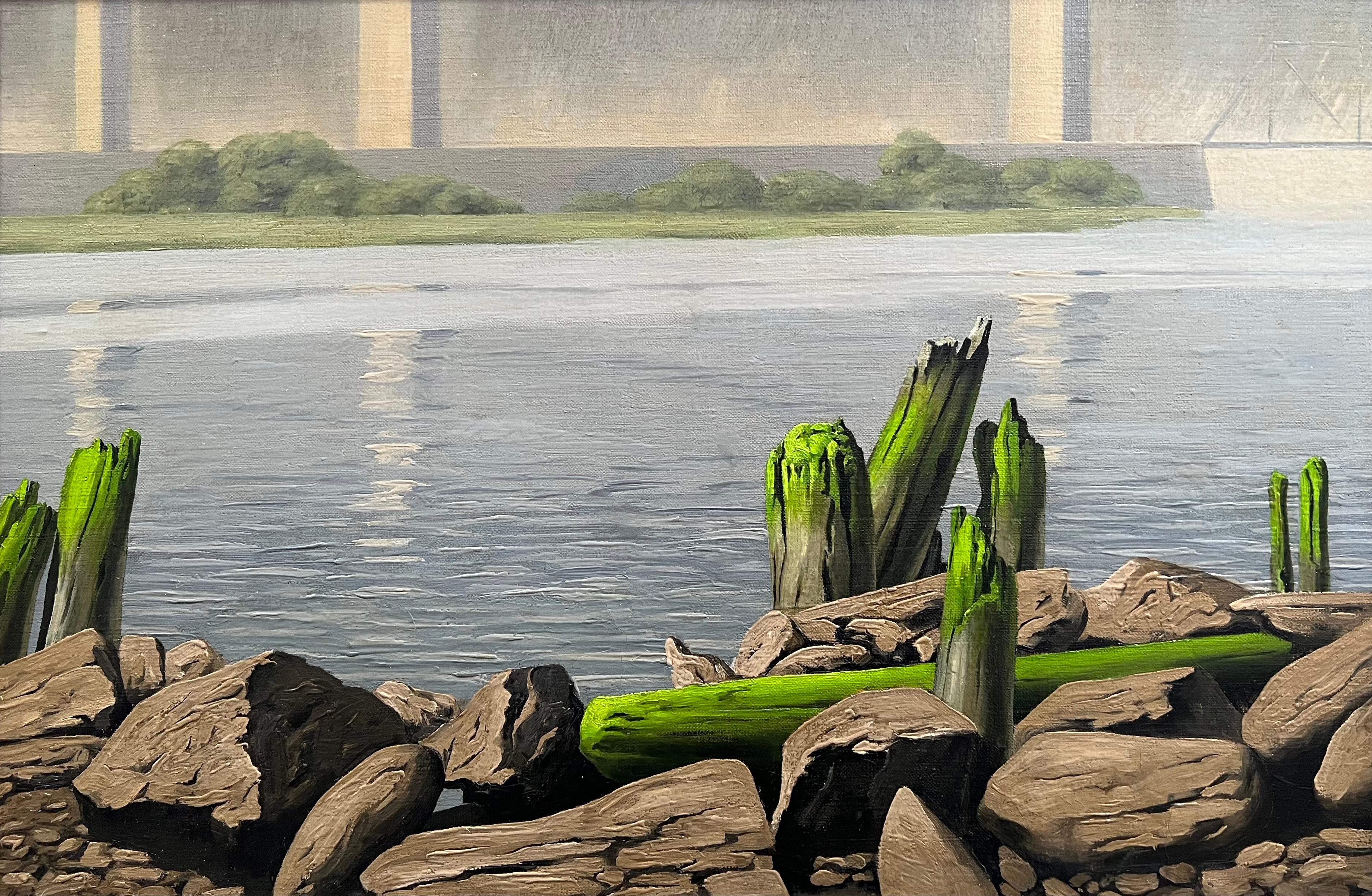Items Similar to The Old Monastery Wall
Want more images or videos?
Request additional images or videos from the seller
1 of 8
William S. SchwartzThe Old Monastery Wall1927
1927
About the Item
Signed (at lower left): WILLIAM S. SCHWARTZ
- Creator:William S. Schwartz (1896-1977, American, Russian)
- Creation Year:1927
- Dimensions:Height: 30 in (76.2 cm)Width: 36 in (91.44 cm)Depth: 1.5 in (3.81 cm)
- Medium:
- Movement & Style:
- Period:
- Condition:
- Gallery Location:New York, NY
- Reference Number:
About the Seller
5.0
Recognized Seller
These prestigious sellers are industry leaders and represent the highest echelon for item quality and design.
Established in 1952
1stDibs seller since 2010
32 sales on 1stDibs
Typical response time: 10 hours
Associations
Art Dealers Association of America
- ShippingRetrieving quote...Ships From: New York, NY
- Return PolicyThis item cannot be returned.
More From This SellerView All
- San Pedro HarborBy Paul SampleLocated in New York, NYIt is infrequent, to say the least, that a diagnosis of tuberculosis proves fortuitous, but that was the event, in 1921, that set Paul Starrett Sample on the road to becoming a professional artist. (The best source for an overview of Sample’s life and oeuvre remains Paul Sample: Painter of the American Scene, exhib. cat., [Hanover, New Hampshire: Hood Museum of Art, 1988] with a detailed and definitive chronology by Sample scholar, Paula F. Glick, and an essay by Robert L. McGrath. It is the source for this essay unless otherwise indicated.) Sample, born in Louisville, Kentucky, in 1896 to a construction engineer and his wife, spent his childhood moving with his family to the various locations that his father’s work took them. By 1911, the family had landed in Glencoe, Illinois, settling long enough for Paul to graduate from New Trier High School in 1916. Sample enrolled at Dartmouth College, in Hanover, New Hampshire, where his interests were anything but academic. His enthusiasms included the football and basketball teams, boxing, pledging at a fraternity, and learning to play the saxophone. After the United States entered World War I, Sample, to his family’s dismay, signed on for the Naval Reserve, leading directly to a hiatus from Dartmouth. In 1918 and 1919, Sample served in the U.S. Merchant Marine where he earned a third mate’s license and seriously contemplated life as a sailor. Acceding to parental pressure, he returned to Dartmouth, graduating in 1921. Sample’s undergraduate life revolved around sports and a jazz band he formed with his brother, Donald, two years younger and also a Dartmouth student. In November 1933, Sample summarized his life in a letter he wrote introducing himself to Frederick Newlin Price, founder of Ferargil Galleries, who would become his New York art dealer. The artist characterized his undergraduate years as spent “wasting my time intensively.” He told Price that that “I took an art appreciation course and slept thru it every day” (Ferargil Galleries Records, circa 1900–63, Archives of American Art, Smithsonian Institution, available on line). In 1920, Donald Sample contracted tuberculosis. He went for treatment to the world-famous Trudeau Sanitorium at Saranac Lake, in New York State’s Adirondack Mountains for the prescribed regimen of rest, healthful food, and fresh air. Visiting his brother in 1921, Paul also contracted the disease. Tuberculosis is highly contagious, and had no certain cure before the development of streptomycin in 1946. Even for patients who appeared to have recovered, there was a significant rate of recurrence. Thus, in his letter to Price, Sample avoided the stigma conjured by naming the disease, but wrote “I had a relapse with a bad lung and spent the next four years hospitalized in Saranac Lake.” The stringent physical restrictions imposed by adherence to “the cure” required Sample to cultivate an alternate set of interests. He read voraciously and, at the suggestion of his physician, contacted the husband of a fellow patient for instruction in art. That artist, then living in Saranac, was Jonas Lie (1880–1940), a prominent Norwegian-American painter and an associate academician at the National Academy of Design. Lie had gained renown for his dramatic 1913 series of paintings documenting the construction of the Panama Canal (The Metropolitan Museum of Art, New York; United States Military Academy, West Point, New York). Primarily a landscape artist, Lie had a particular affinity for scenes with water. His paintings, impressionistic, atmospheric, and brushy, never strayed from a realistic rendering of his subject. Sample regarded Lie as a mentor and retained a lifelong reverence for his teacher. Sample’s early paintings very much reflect Lie’s influence. ` In 1925, “cured,” Sample left Saranac Lake for what proved to be a brief stay in New York City, where his veteran’s benefits financed a commercial art course. The family, however, had moved to California, in the futile hope that the climate would benefit Donald. Sample joined them and after Donald’s death, remained in California, taking classes at the Otis Art Institute in Los Angeles. In Sample’s account to Price, “I couldn’t stomach the practice of painting a lot of High Sierras and desert flowers which seemed to be the only kind of pictures that were sold here so I got a job teaching drawing and painting at the art school of the University of Southern California.” Initially hired as a part-time instructor, Sample progressed to full-time status and ultimately, by the mid-1930s, to the post of Chairman of the Fine Art Department. Sample, however, did not want to wind up as a professor. “Teaching is all right in small doses,” he wrote, “but I have a horror of drifting into being a college professor and nothing more.” At the same time as he taught, Sample began to exhibit his work in a variety of venues at first locally, then nationally. Though he confessed himself “a terrible salesman,” and though occupied with continued learning and teaching, Sample was nonetheless, ambitious. In 1927, he wrote in his diary, “I am eventually going to be a painter and a damned good one. And what is more, I am going to make money at it” (as quoted by Glick, p. 15). In 1928, Sample felt sufficiently solvent to marry his long-time love, Sylvia Howland, who had also been a patient at Saranac Lake. The Howland family were rooted New Englanders and in summertime the Samples regularly traveled East for family reunion vacations. While the 1930s brought serious hardship to many artists, for Paul Sample it was a decade of success. Buttressed by the financial safety net of his teacher’s salary, he painted realist depictions of the American scene. While his work addressed depression-era conditions with a sympathetic eye, Sample avoided the anger and tinge of bitterness that characterized much contemporary realist art. Beginning in 1930, Sample began to exhibit regularly in juried exhibitions at important national venues, garnering prizes along the way. In 1930, Inner Harbor won an honorable mention in the Annual Exhibition of the Art Institute of Chicago. That same year Sample was also represented in a show at the Albright-Knox Gallery in Buffalo and at the Biennial Exhibition of the Corcoran Gallery of Art, Washington, D.C. In 1931, Dairy Ranch won the second Hallgarten Prize at the Annual Exhibition of the National Academy of Design, in New York. Sample also made his first appearances at the Carnegie Institute, Pittsburgh, and The Pennsylvania Academy of the Fine Arts, Philadelphia. In 1936, Miner’s Resting won the Temple Gold Medal at the Pennsylvania Academy’s Annual Exhibition. Always interested in watercolor, in 1936, Sample began to send works on paper to exhibitions at the Whitney Museum, New York. While participating in juried exhibitions, Sample also cultivated commercial possibilities. His first New York art dealer was the prestigious Macbeth Gallery in New York, which included his work in a November 1931 exhibition. In 1934, Sample joined the Ferargil Galleries in New York, after Fred Price arranged the sale of Sample’s Church Supper to the Michele and Donald D’Amour Museum of Fine Arts in Springfield, Massachusetts. In 1937, The Metropolitan Museum of Art purchased Sample’s Janitor’s Holiday from the annual exhibition of the National Academy of Design, a notable honor. As prestigious as this exhibition schedule may have been, by far Sample’s most visible presence in the 1930s and 1940s was the result of his relationship with Henry Luce’s burgeoning publishing empire, Time, Inc. Sample’s first contribution to a Luce publication appears to have been another San Pedro...Category
20th Century American Modern Landscape Paintings
MaterialsCanvas, Oil
- Bird in CageLocated in New York, NYGouache on board, 20 x 24 in. Signed (at lower right): Atherton Painted about 1940 RECORDED: Art News (May 11, 1940), illus. [clipping citation] EXHIBITED: The Art Institute of Chicago, 1940, The International Watercolor Exhibition, no. 156, illus. on cover as Bird in Cage...Category
Mid-20th Century American Modern Landscape Paintings
MaterialsTempera, Wood Panel
- Saint-Malo, BrittanyBy William Stanley HaseltineLocated in New York, NYThe career of William Stanley Haseltine spans the entire second half of the nineteenth century. During these years he witnessed the growth and decline of American landscape painting, the new concept of plein-air painting practiced by the Barbizon artists, and the revolutionary techniques of the French Impressionists, all of which had profound effects on the development of painting in the western world. Haseltine remained open to these new developments, selecting aspects of each and assimilating them into his work. What remained constant was his love of nature and his skill at rendering exactly what he saw. His views, at once precise and poetic, are, in effect, portraits of the many places he visited and the landscapes he loved. Haseltine was born in Philadelphia, the son of a prosperous businessman. In 1850, at the age of fifteen, he began his art studies with Paul Weber, a German artist who had settled in Philadelphia two years earlier. From Weber, Haseltine learned about Romanticism and the meticulous draftsmanship that characterized the German School. At the same time, Haseltine enrolled at the University of Pennsylvania, and took sketching trips around the Pennsylvania countryside, exploring areas along the Delaware and Susquehanna rivers. Following his sophomore year, Haseltine transferred to Harvard University. After graduating from Harvard in 1854, Haseltine returned to Philadelphia and resumed his studies with Weber. Although Weber encouraged Haseltine to continue his training in Europe, the elder Haseltine was reluctant to encourage his son to pursue a career as an artist. During the next year, Haseltine took various sketching trips along the Hudson River and produced a number of pictures, some of which were exhibited at the Pennsylvania Academy of the Fine Arts in the spring of 1855. Ultimately, having convinced his father that he should be allowed to study in Europe, Haseltine accompanied Weber to Düsseldorf. The Düsseldorf Academy was, during the 1850s, at the peak of its popularity among American artists. The Academy’s strict course of study emphasized the importance of accurate draftsmanship and a strong sense of professionalism. Landscape painting was the dominant department at the Düsseldorf Academy during this period, and the most famous landscape painter there was Andreas Achenbach, under whom Haseltine studied. Achenbach’s realistic style stressed close observation of form and detail, and reinforced much of what Haseltine had already learned. His Düsseldorf training remained an important influence on him for the rest of his life. At Düsseldorf, Haseltine became friendly with other American artists studying there, especially Emanuel Leutze, Worthington Whittredge, and Albert Bierstadt. They were constant companions, and in the spring and summer months took sketching trips together. In the summer of 1856 the group took a tour of the Rhine, Ahr, and Nahe valleys, continuing through the Swiss alps and over the Saint Gotthard Pass into northern Italy. The following summer Haseltine, Whittredge, and the painter John Irving returned to Switzerland and Italy, and this time continued on to Rome. Rome was a fertile ground for artists at mid-century. When Haseltine arrived in the fall of 1857, the American sculptors Harriet Hosmer, Chauncey B. Ives, Joseph Mozier, William Henry Rinehart...Category
19th Century American Realist Landscape Paintings
MaterialsCanvas, Oil
- Chestnut Racehorse with a Jockey Up On a Training StrapBy Henry H. CrossLocated in New York, NYIt was Henry Cross's portraits of horses belonging to the prominent breeders and trainers of the second half of the nineteenth century that won the artist renown as an animal painter. Born and raised in upstate New York, Cross's proficiency in both drafting and caricature was revealed while he was still a student at the Binghamton Academy, New York. In 1852, when he was only fifteen years old, Cross joined a traveling circus that took him to Minneapolis, Minnesota, and to the first of many Indian encampments that he would draw upon for subject matter throughout his career. Biographers differ as to the year Cross left for Europe, however, he was in Paris from 1852 to 1853 or 1854, where he studied with Rosa Bonheur, a highly esteemed French painter of horses. Upon Cross's return to the United States he was commissioned to paint the studs of wealthy horsemen, including those of Commodore Cornelius Vanderbilt, Robert Bonner, the owner-publisher of The New York Ledger, and "Copper King" Marcus Daly, whose 18,000 acre stock farm was reputed to be the greatest and most valuable horse ranch in the world. Although Cross received the highest pay of any equine artist of his day (up to $35,000. for one order, according to The Horse Review of April 10, 1918, p. 328), he frequently joined traveling circuses and painted the locales where they visited. He also painted portraits of notable contemporaries, such as President Abraham Lincoln, ex-president Ulysses S. Grant, King Edward VII of England, W. F. "Buffalo Bill...Category
19th Century American Realist Animal Paintings
MaterialsCanvas, Oil
- Copley Square, BostonBy Thomas FransioliLocated in New York, NYThomas Fransioli’s cityscapes are crisp and tidy. Buildings stand in bold outline, trees are sharp, and saturated color permeates the scene. But Fransioli’s cities often lack one critical feature: people. His streets are largely deserted, save for the rare appearance of figure and the occasional black cat scurrying across pavement. Instead, humanity is implied. Magic Realism neatly characterizes Fransioli’s viewpoint. First applied to American art in the 1943 MoMA exhibition “American Realists and Magic Realists...Category
20th Century American Realist Landscape Paintings
MaterialsCanvas, Oil
- Strawberries Strewn on a Forest FloorBy William Mason BrownLocated in New York, NYWilliam Mason Brown was born in Troy, New York, where he studied for several years with local artists, including the leading portraitist there, Abel Buel Moore. In 1850, he moved to ...Category
19th Century American Realist Landscape Paintings
MaterialsCanvas, Oil
You May Also Like
- Americana Landscape Oil on Canvas Painting Signed P. Paul, FramedLocated in Plainview, NYAn elegant oil on canvas landscape painting featuring a lake view in a paradisiac environment. The painting is finely framed in custom giltwood frame. A wonderful addition to any liv...Category
1980s American Modern Landscape Paintings
MaterialsOil, Canvas
- Six O'ClockLocated in Los Angeles, CASix O-Clock, c. 1942, oil on canvas, 30 x 20 inches, signed and titled several times verso of frame and stretcher (perhaps by another hand), marked “Rehn” several times on frame (for the Frank K. M. Rehn Galleries in New York City, who represented Craig at the time); Exhibited: 1) 18th Biennial Exhibition of Contemporary American Oil Paintings from March 21 to May 2, 1943 at The Corcoran Gallery of Art in Washington, D.C. #87, original price $450 (per catalog) (exhibition label verso), 2) Craig’s one-man show at the Frank K. M. Rehn Galleries, New York City, from October 26 to November 14, 1942, #10 (original price listed as $350); and 3) Exhibition of thirty paintings sponsored by the Harrisburg Art Association at the State Museum of Pennsylvania in Harrisburg in March, 1944 (concerning this exhibit, Penelope Redd of The Evening News (Harrisburg, Pennsylvania) wrote: “Other paintings that have overtones of superrealism inherent in the subjects include Tom Craig’s California nocturne, ‘Six O’Clock,’ two figures moving through the twilight . . . .” March 6, 1944, p. 13); another label verso from The Museum of Art of Toledo (Ohio): original frame: Provenance includes George Stern Gallery, Los Angeles, CA About the Painting Long before Chris Burden’s iconic installation outside of the Los Angeles County Museum of Art, Urban Light, another artist, Tom Craig, made Southern California streetlights the subject of one of his early 1940s paintings. Consisting of dozens of recycled streetlights from the 1920s and 1930s forming a classical colonnade at the museum’s entrance, Burden’s Urban Light has become a symbol of Los Angeles. For Burden, the streetlights represent what constitutes an advanced society, something “safe after dark and beautiful to behold.” It seems that Craig is playing on the same theme in Six O-Clock. Although we see two hunched figures trudging along the sidewalk at the end of a long day, the real stars of this painting are the streetlights which brighten the twilight and silhouette another iconic symbol of Los Angeles, the palm trees in the distance. Mountains in the background and the distant view of a suburban neighborhood join the streetlights and palm trees as classic subject matter for a California Scene painting, but Craig gives us a twist by depicting the scene not as a sun-drenched natural expanse. Rather, Craig uses thin layers of oil paint, mimicking the watercolor technique for which he is most famous, to show us the twinkling beauty of manmade light and the safety it affords. Although Southern California is a land of natural wonders, the interventions of humanity are already everywhere in Los Angeles and as one critic noted, the resulting painting has an air of “superrealism.” About the Artist Thomas Theodore Craig was a well-known fixture in the Southern California art scene. He was born in Upland California. Craig graduated with a degree in botany from Pomona College and studied painting at Pamona and the Chouinard Art School with Stanton MacDonald-Wright and Barse Miller among others. He became close friends with fellow artist Milford Zornes...Category
1940s American Modern Landscape Paintings
MaterialsCanvas, Oil
- Gracie MansionBy Isabella Banks MarkellLocated in Los Angeles, CAThis painting is part of our exhibition America Coast to Coast: Artists of the 1940s. Gracie Mansion, c. 1944, oil on canvas, signed lower right, 25 x 30 inches, presented in a ne...Category
1940s American Modern Paintings
MaterialsCanvas, Oil
- Gold Mine, Central City, ColoradoBy Joseph MeertLocated in Los Angeles, CAThis painting is part of our exhibition America Coast to Coast: Artists of the 1930s Goldmine, Central City, Colorado, oil on canvas, 36 x 28 inches, c. 1936, signed lower right, ex collection of Platt Fine Art, Chicago, Illinois (label verso). About the Painting Joseph Meert’s painting, Goldmine, Central City, Colorado, depicts the short-lived resurrection of a once prominent city just outside Denver. Central City was founded in 1859 soon after John Gregory struck gold in the area. As word spread, thousands of miners converged into “Gregory’s Gulch” and its surroundings became known as the “richest square mile on earth.” Mining production quickly increased resulting in Central City to becoming Colorado’s largest city in the early 1860s. Despite some technical difficulties transitioning to lode mining and the rise of competition from Leadville, Central City remained an economic boom town through the turn of the century. But, with every boom, there is a bust. World War I marked the end of Central City’s prominence as ore production ground to a halt and by 1925, the town’s population shrank to only 400 people. The desperation of the Great Depression and a nearly 100% increase in the price of gold lured labor and capital back to Central City. Meert painted in Colorado during the mid-1930s, a time when he created his most desirable works. It is during this period of renaissance that Meert captures one of Central City's outlying dirt streets bordered by 19th century wooden houses from the town's heyday and the more recently installed electric lines leading to a distant gold mine. A lone figure trudges up the hill, a mother with a baby in her arms, putting us in mind of the rebirth of the town itself. Meert had solo exhibitions at the Colorado Springs Fine Arts Center in 1936 and the Denver Art Museum. Although it is not known whether Goldmine, Central City was included in either of these exhibitions, it seems likely. Moreover, the painting is closely related to Meert’s painting, The Old Road, which was painted in 1936 and exhibited at the Corcoran Gallery of Art in Washington, DC and at the Dallas Museum of Art. About the Artist Joseph Meert was a well-regarded painter and muralist, who initially made a name for himself in the American Scene and later as an abstract expressionist. Although initially successful, Meert struggled financially and with mental illness later in life. He was born in Brussels, Belgium, but moved with his family to Kansas City, Missouri. As a child, a chance encounter at the Union Pacific Railyard changed his life. Meert happened upon a worker repainting and stenciling a design on a railroad car. Meert later recalled that this experience introduced him to the idea of being a painter. Without support from his father, Meert obtained a working scholarship to the Kansas City Art Institute. After four years at the Kansas City Art Institute, Meert studied seven years at the Art Students League and in Europe and Los Angeles. At the Art Students League, Meert fell under the spell of Thomas Hart Benton and Stanton MacDonald-Wright. In 1931, he befriended Jackson Pollock. By 1934, Meert was part of the Public Works of Art Project when he met his wife, Margaret Mullin...Category
1930s American Modern Landscape Paintings
MaterialsCanvas, Oil
- Church in TreesLocated in Los Angeles, CAThis painting is part of our exhibition Charles Goeller: A Wistful Loneliness. Oil on canvas, 13 x 9 inches, Signed lower leftCategory
1940s American Modern Landscape Paintings
MaterialsOil, Canvas
- Arthur KillLocated in Los Angeles, CAThis painting is part of our exhibition Charles Goeller: A Wistful Loneliness. Oil on canvas, 15 ¾ x 24 inches, Signed and titled verso on stretcher Exhibited: [Solo Exhibition] Cha...Category
1940s American Modern Landscape Paintings
MaterialsCanvas, Oil
Recently Viewed
View AllMore Ways To Browse
Old Antique Signs
Old Antique Sign
Monastery Painting
William S Schwartz
French Barn
Antique Oil Painting English Landscape
Summer Palace
Mexico Poster
Bucolic Landscape
Portugal Landscapes
Parisian Street Scene Painting
Forest Hills
Painting 1843
Garden Sketch
St Cloud
Oil Paintings Portugal
Portuguese Oil Paintings
Landscape With Waterfall
